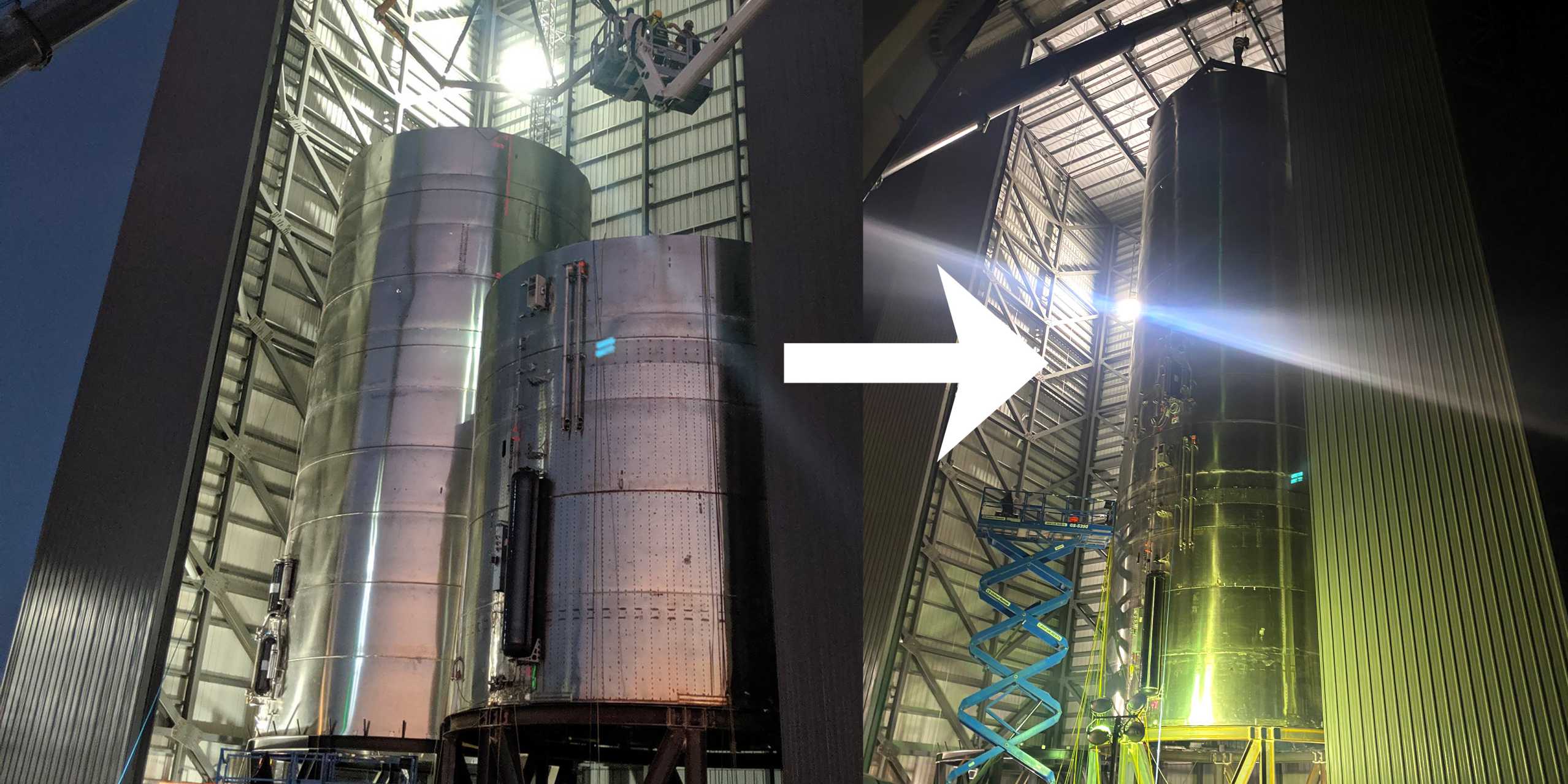
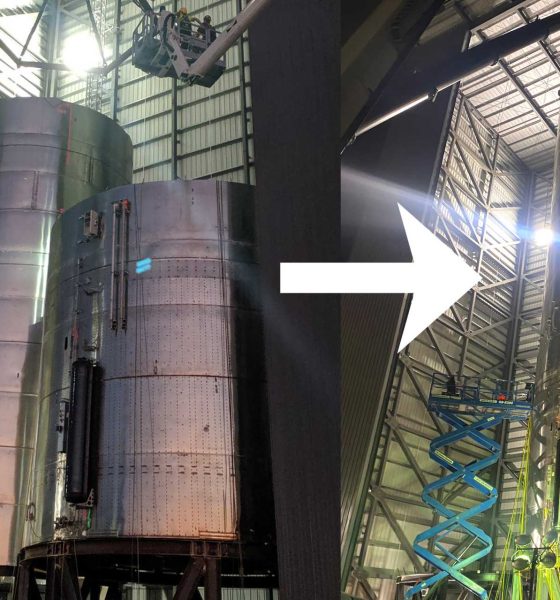
News
SpaceX Starship launch pad upgraded as Elon Musk reveals rocket production milestone
SpaceX has begun to upgrade its South Texas Starship launch pad in anticipation of the completion of the next full-scale rocket prototype, photos of which CEO Elon Musk revealed just hours ago.
Working in parallel with efforts to repair damage caused by Starship serial number 1’s (SN1) violent February 28th test failure, SpaceX has managed to build, complete, and test an entirely separate ‘test tank’ and complete fabrication of a second full-scale Starship in a handful of weeks. Flexing the growing capabilities of the impressive Boca Chica, Texas Starship factory SpaceX has sprung up in just three months, the company is working around the clock to build not just one – but several – Starship prototypes simultaneously.
A successful March 9th tank test designed to prove a new thrust structure design managed to do just that less than two weeks after the same faulty part brought about Starship SN1’s demise. In the two weeks since that its test completion, SpaceX has been busy welding, stacking, welding, and stacking several separate sections of the next Starship prototype, known as SN3. Potentially a matter of days away from structural completion, focus has recently shifted to the launch pad the ship will be tested at. In the last few days, SpaceX technicians have begun to install a bizarre, new structural element on the mount Starship SN3 will be secured on top of, hinting at the goals of the rocket’s first test campaign.
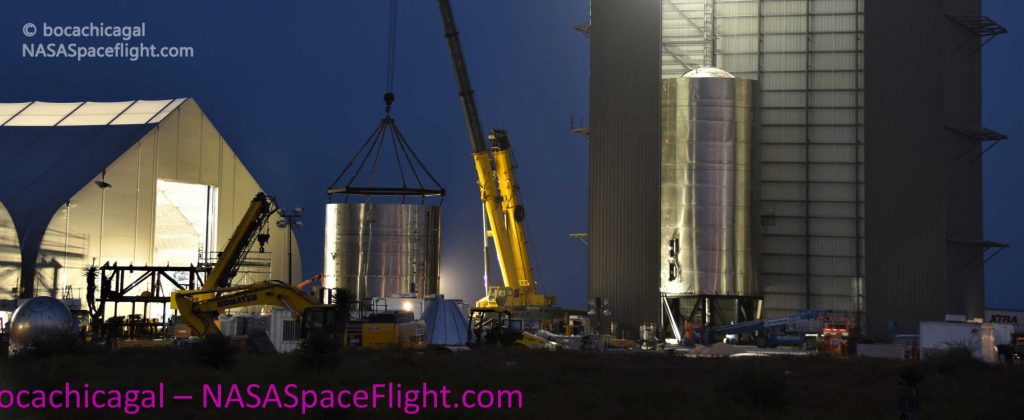
Squeezing in alongside efforts to repair the propellant lines that run into the launch mount, upgrades began on March 24th as a SpaceX team worked to install what looked like an incredibly sturdy tripod (with four ‘legs’, of course). Thanks to familiar testing done with SpaceX’s most recent Starship tank prototype, the purpose of the launch mount’s newest appendage quickly became clear.
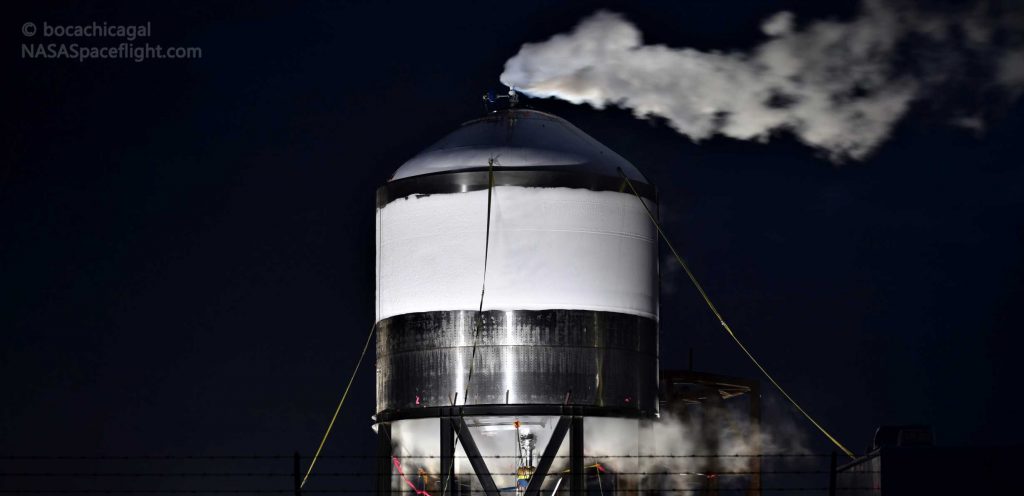
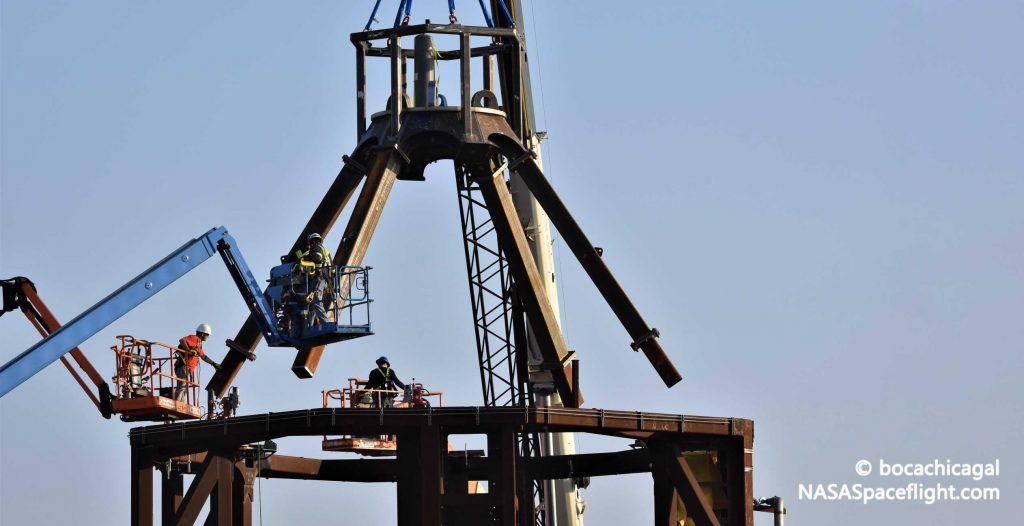
During the Starship SN2 tank’s thrust structure (‘thrust puck’, per Elon Musk) test campaign, SpaceX debuted the concurrent use of a beefy hydraulic jack to simulate the forces a Raptor engine static might produce. Capable of producing upwards of 200 metric tons (440,000 lbf) of thrust at full power, SpaceX will likely begin Starship static fire tests with a single Raptor engine. As soon as a Starship prototype completes one or several single-engine test fires, the plan is to install three sea level-optimized Raptor engines and repeat static fire tests.
Before that triple-engine static fire milestone, a first for the cutting-edge Raptor engine, SpaceX needs to verify that Starship’s thrust structure can stand up to the ~600 tons (~1.3M lbf) of force it will be subjected to during such a test. Sitting on a much smaller stand, Starship SN2 used a single hydraulic jack and temporary stand to simulate a single engine’s thrust. Starship SN3, sitting much higher above the ground, will need three jacks to simulate three Raptors.
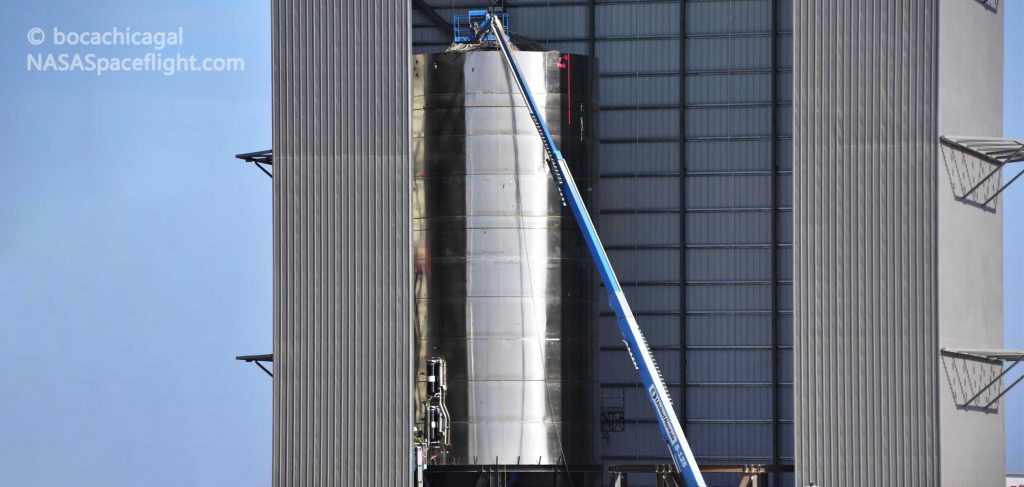
As such, it looks likely that Starship SN3’s first cryogenic tank proof test – filling the vehicle with inert liquid nitrogen – will coincide with a second dedicated stress test of a Starship thrust structure, hopefully proving itself capable of surviving the force of three Raptor engines at full thrust. While orbital-class Starships will need three more vacuum-optimized Raptor engines, three sea-level engines are all SpaceX needs to begin flight tests with suborbital prototypes.
Based on an unofficial analysis of existing photos, it appears that every single major structural piece of Starship SN3 – excluding legs and fins – is nearing completion, even including the ship’s shiny nosecone. Likely to head to the launch pad for its first tests as soon as the tank section alone has been completed, just one stacking event remains before said tank section reaches its full height. Right now, both of those parts have been moved to a dedicated Vehicle/Vertical Assembly Building (VAB) and are probably no more than a day or two away from being joined*. Perhaps just a day or two after that milestone, SpaceX will likely transport the massive rocket to the launch pad to begin preparing for its first proof tests.
*Around 3am local time, SpaceX technicians stacked Starship SN3’s two main segments, completing its tank and engine section.

Elon Musk
Starlink passes 9 million active customers just weeks after hitting 8 million
The milestone highlights the accelerating growth of Starlink, which has now been adding over 20,000 new users per day.

SpaceX’s Starlink satellite internet service has continued its rapid global expansion, surpassing 9 million active customers just weeks after crossing the 8 million mark.
The milestone highlights the accelerating growth of Starlink, which has now been adding over 20,000 new users per day.
9 million customers
In a post on X, SpaceX stated that Starlink now serves over 9 million active users across 155 countries, territories, and markets. The company reached 8 million customers in early November, meaning it added roughly 1 million subscribers in under seven weeks, or about 21,275 new users on average per day.
“Starlink is connecting more than 9M active customers with high-speed internet across 155 countries, territories, and many other markets,” Starlink wrote in a post on its official X account. SpaceX President Gwynne Shotwell also celebrated the milestone on X. “A huge thank you to all of our customers and congrats to the Starlink team for such an incredible product,” she wrote.
That growth rate reflects both rising demand for broadband in underserved regions and Starlink’s expanding satellite constellation, which now includes more than 9,000 low-Earth-orbit satellites designed to deliver high-speed, low-latency internet worldwide.
Starlink’s momentum
Starlink’s momentum has been building up. SpaceX reported 4.6 million Starlink customers in December 2024, followed by 7 million by August 2025, and 8 million customers in November. Independent data also suggests Starlink usage is rising sharply, with Cloudflare reporting that global web traffic from Starlink users more than doubled in 2025, as noted in an Insider report.
Starlink’s momentum is increasingly tied to SpaceX’s broader financial outlook. Elon Musk has said the satellite network is “by far” the company’s largest revenue driver, and reports suggest SpaceX may be positioning itself for an initial public offering as soon as next year, with valuations estimated as high as $1.5 trillion. Musk has also suggested in the past that Starlink could have its own IPO in the future.
News
NVIDIA Director of Robotics: Tesla FSD v14 is the first AI to pass the “Physical Turing Test”
After testing FSD v14, Fan stated that his experience with FSD felt magical at first, but it soon started to feel like a routine.

NVIDIA Director of Robotics Jim Fan has praised Tesla’s Full Self-Driving (Supervised) v14 as the first AI to pass what he described as a “Physical Turing Test.”
After testing FSD v14, Fan stated that his experience with FSD felt magical at first, but it soon started to feel like a routine. And just like smartphones today, removing it now would “actively hurt.”
Jim Fan’s hands-on FSD v14 impressions
Fan, a leading researcher in embodied AI who is currently solving Physical AI at NVIDIA and spearheading the company’s Project GR00T initiative, noted that he actually was late to the Tesla game. He was, however, one of the first to try out FSD v14.
“I was very late to own a Tesla but among the earliest to try out FSD v14. It’s perhaps the first time I experience an AI that passes the Physical Turing Test: after a long day at work, you press a button, lay back, and couldn’t tell if a neural net or a human drove you home,” Fan wrote in a post on X.
Fan added: “Despite knowing exactly how robot learning works, I still find it magical watching the steering wheel turn by itself. First it feels surreal, next it becomes routine. Then, like the smartphone, taking it away actively hurts. This is how humanity gets rewired and glued to god-like technologies.”
The Physical Turing Test
The original Turing Test was conceived by Alan Turing in 1950, and it was aimed at determining if a machine could exhibit behavior that is equivalent to or indistinguishable from a human. By focusing on text-based conversations, the original Turing Test set a high bar for natural language processing and machine learning.
This test has been passed by today’s large language models. However, the capability to converse in a humanlike manner is a completely different challenge from performing real-world problem-solving or physical interactions. Thus, Fan introduced the Physical Turing Test, which challenges AI systems to demonstrate intelligence through physical actions.
Based on Fan’s comments, Tesla has demonstrated these intelligent physical actions with FSD v14. Elon Musk agreed with the NVIDIA executive, stating in a post on X that with FSD v14, “you can sense the sentience maturing.” Musk also praised Tesla AI, calling it the best “real-world AI” today.
News
Tesla AI team burns the Christmas midnight oil by releasing FSD v14.2.2.1
The update was released just a day after FSD v14.2.2 started rolling out to customers.

Tesla is burning the midnight oil this Christmas, with the Tesla AI team quietly rolling out Full Self-Driving (Supervised) v14.2.2.1 just a day after FSD v14.2.2 started rolling out to customers.
Tesla owner shares insights on FSD v14.2.2.1
Longtime Tesla owner and FSD tester @BLKMDL3 shared some insights following several drives with FSD v14.2.2.1 in rainy Los Angeles conditions with standing water and faded lane lines. He reported zero steering hesitation or stutter, confident lane changes, and maneuvers executed with precision that evoked the performance of Tesla’s driverless Robotaxis in Austin.
Parking performance impressed, with most spots nailed perfectly, including tight, sharp turns, in single attempts without shaky steering. One minor offset happened only due to another vehicle that was parked over the line, which FSD accommodated by a few extra inches. In rain that typically erases road markings, FSD visualized lanes and turn lines better than humans, positioning itself flawlessly when entering new streets as well.
“Took it up a dark, wet, and twisty canyon road up and down the hill tonight and it went very well as to be expected. Stayed centered in the lane, kept speed well and gives a confidence inspiring steering feel where it handles these curvy roads better than the majority of human drivers,” the Tesla owner wrote in a post on X.
Tesla’s FSD v14.2.2 update
Just a day before FSD v14.2.2.1’s release, Tesla rolled out FSD v14.2.2, which was focused on smoother real-world performance, better obstacle awareness, and precise end-of-trip routing. According to the update’s release notes, FSD v14.2.2 upgrades the vision encoder neural network with higher resolution features, enhancing detection of emergency vehicles, road obstacles, and human gestures.
New Arrival Options also allowed users to select preferred drop-off styles, such as Parking Lot, Street, Driveway, Parking Garage, or Curbside, with the navigation pin automatically adjusting to the ideal spot. Other refinements include pulling over for emergency vehicles, real-time vision-based detours for blocked roads, improved gate and debris handling, and Speed Profiles for customized driving styles.








